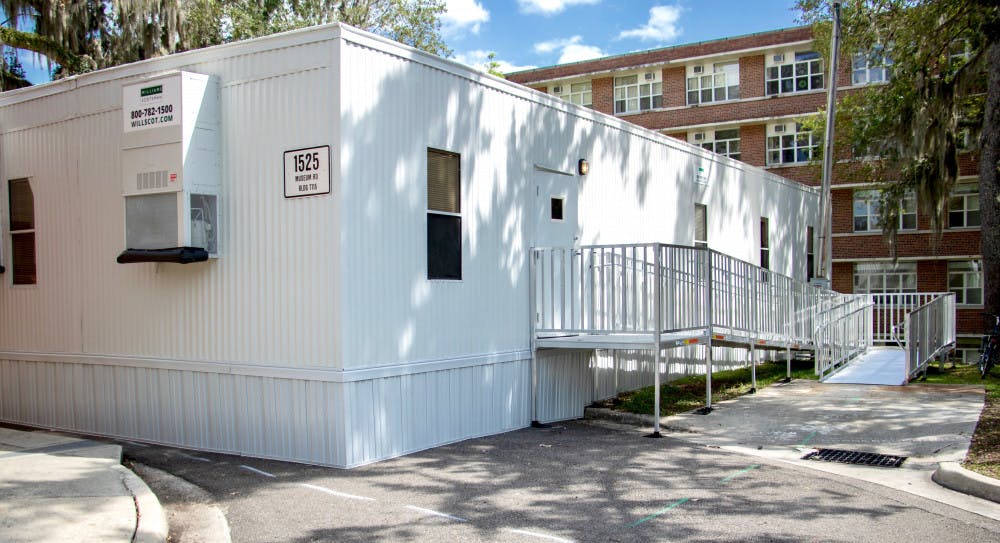Every work day, Sgt. Walter Hamby walks into the University Police building at 5:30 a.m., gears up in his uniform and weaponry, conducts roll call and checks the police vehicles.
On Nov. 5, Hamby was going through the same routine, searching for radios in room 108B, a weapons storage on the first floor where guns, radios and a wooden podium are kept.
But as he walked toward the radios, Hamby’s right foot faltered. In a matter of seconds, the 6-foot officer was knee-deep in the floor. He tried to pull himself up, but was unsuccessful. He called Officer Steve Wilder to help him out. The floor began to collapse under Wilder as he rescued Hamby, but no one was injured.
“You think you’re standing on a firm surface and all of a sudden it disappears from under you,” Hamby said.
The UPD building, at 1555 Museum Road, experienced problems with mold, asbestos, humidity and weak flooring over the last few months. There is always someone in the 3,572 sq. ft. building, which 50 employees work out of, but it can no longer support the needs of the department, said Deputy Chief Darren Baxley.
“It’s just not ideal to run a modern police department out of,” Baxley said.
The staff will vacate this week and work out of a modular building — of three portables bolted together — near Jennings Hall while the building is assessed for safety and tested by a private contractor, which could take about three weeks. The temporary facility will be about 3,500 square feet and cost $2,200 to rent per month, said Curtis Reynolds, the vice president of UF’s Business Affairs.
“Considering its age and considering its wood structure, there might be other concerns that we’re not aware of,” Reynolds said. “We’re taking this full collapse as a signal to us that there are potential issues inside the building that we may not be aware of.”
According to UF Libraries’ Historic Sites Guide, the building was first constructed in 1928 to house the WRUF radio station. In 1957, UPD moved in.
In 1989, the building was added to the National Register of Historic Places. Under the special classification, it’s hard to get renovations approved for the building.
“That makes it very challenging to do any kind of remodel in there to make it more appropriate for a police department,” Baxley said.
The department has been trying to get a new building for about a decade, Baxley said.
Another room in the building, a conference room, was deemed structurally unsound and closed off while the base was filled with concrete. Thomas Ladun, a coordinator for UF Environmental Health and Safety, discovered the wood trusses that hold up the floor were rotten from rainwater draining under the building over the years. Ladun said when the water evaporates, it goes up into the floor, weakening it.
Ladun discovered the rotten wood after working on an asbestos case in the room. In September 2017, contractors found asbestos floor tile about two layers underneath the conference room floor, which had been covered over the years. He said asbestos appearances are common for older buildings, and the tile was removed in the renovation.
“It wasn’t dangerous or anything, but it is regulated,” he said.
Ladun said he did a walk-through of the building with the UF Environmental Health and Safety in October. He noted the floor was sagging in the room where Hamby fell. This was eventually pointed out to Facility Services.
Outside consultants also found the humidity on the first floor was above 60 percent in January. In a well air-conditioned building, the humidity is between 55 percent and 60 percent. He said if levels are consistently above 60 percent for hours or days, there might be something wrong with the building.
The pool of rainwater underneath the building could contribute to the increase of the relative humidity, Ladun said.
“You’re relying on the air conditioning to dry out the building and keep that moisture in check,” he said. “At a certain point, it’s possible that you’d have too much moisture so the air conditioning can no longer keep the building dry.”
Hamby said he knew the floor was weak for at least a year before he fell into it. With the staff of the building moving into the trailers by this week, Hamby, who’s been with the department for 30 years, said he might retire in the modular building.
“It would be nice to have a place where we wouldn’t have to worry about that again,” he said.
Contact Christina Morales at cmorales@alligator.org. Follow her on Twitter at @Christina_M18.
University Police staff will move into a modular building — of three portables bolted together — while their building is assessed for safety and tested by a private contractor, which could take about three weeks. The temporary facility will be about 3,500 square feet and cost $2,200 to rent per month.






